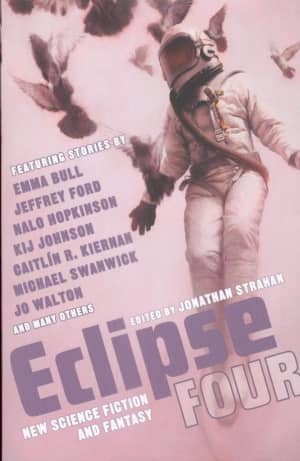Birthday Reviews: Eileen Gunn’s “Thought Experiment”

Eileen Gunn was born on June 23, 1945.
Gunn’s story “Stable Strategies for Middle Management” was nominated for a Hugo Award in 1989 and the next year she received a Hugo nomination for “Computer Friendly.” Her collection Stable Strategies and Others, which included original works, was nominated or shortlisted for the Philip K Dick Award, the James Tiptree, Jr. Memorial Award, and the World Fantasy Award. Two original stories from the collection, “Nirvana High,” written with Leslie What, and “Coming to Terms” were nominated for the Nebula Award, with “Coming to Terms” winning the 2005 Nebula Award for Best Short Story.
Gunn published “Thought Experiment” in Jonathan Strahan’s 2011 anthology Eclipse Four: New Science Fiction and Fantasy. She subsequently included it in her collection Questionable Practices and Paula Guran selected the story for the anthology Time Travel: Recent Trips.
Ralph Drumm is an engineer given to performing the sort of “Thought Experiment” the story is named for. While sitting in a dentist’s chair having his teeth whitened, Drumm begins to muse on a way to achieve time travel and after returning home turns his thought experiment into a reality.
The story follows Drumm as he sight-sees through three different periods, a Wessex in the mid-fifteenth century where the inhabitants seem to speak a version of Anglo Saxon, a visit to Bethel, New York to see Woodstock in 1969, and to Washington, D.C. on April 15, 1865 to witness the assassination of Abraham Lincoln. For the most part, Drumm is only a witness to these events, although he senses hostility towards him on his repeated trips to Wessex, each spaced a year apart so he won’t have to worry about running into himself.
Gunn does bring up the idea of Drumm’s interference with history, not only when he tries to warn Lincoln about Booth’s impending assassination attempt, but on a more subtle level, simply by existing in times when he shouldn’t have. Gunn’s early description of Drumm as the first time traveler also foreshadows the possible existence of other, later time travelers.
Once additional time travelers begin to show up, or rather, are identified as such, Gunn resorts to some scientific technobabble to explain the side effects of Drumm’s solution to the problem of time travel. Because Drumm doesn’t do much in his travels, the explanation for the problems with time travel take center stage, but don’t quite have the heft to carry the story.
Reviewed in its original publication in the anthology Eclipse Four, edited by Jonathan Strahan, Night Shade Books 2011.
 Steven H Silver is a sixteen-time Hugo Award nominee and was the publisher of the Hugo-nominated fanzine Argentus as well as the editor and publisher of ISFiC Press for 8 years. He has also edited books for DAW and NESFA Press. He began publishing short fiction in 2008 and his most recently published story is “Doing Business at Hodputt’s Emporium” in Galaxy’s Edge. Steven has chaired the first Midwest Construction, Windycon three times, and the SFWA Nebula Conference 6 times, as well as serving as the Event Coordinator for SFWA. He was programming chair for Chicon 2000 and Vice Chair of Chicon 7. He has been the news editor for SF Site since 2002.
Steven H Silver is a sixteen-time Hugo Award nominee and was the publisher of the Hugo-nominated fanzine Argentus as well as the editor and publisher of ISFiC Press for 8 years. He has also edited books for DAW and NESFA Press. He began publishing short fiction in 2008 and his most recently published story is “Doing Business at Hodputt’s Emporium” in Galaxy’s Edge. Steven has chaired the first Midwest Construction, Windycon three times, and the SFWA Nebula Conference 6 times, as well as serving as the Event Coordinator for SFWA. He was programming chair for Chicon 2000 and Vice Chair of Chicon 7. He has been the news editor for SF Site since 2002.
A good choice — Eileen Gunn is a really fine writer. There were some other interesting choices, too — Michael Shaara, who wrote a fair amount of SF in the early ’50s before he became famous for THE KILLER ANGELS, Carrie Laben, who has written some fine dark tales over the past decade or so (I used her first sale in on of my early BEST FANTASY volumes), Hugh Howey, and Cixin Liu.
And a once very prominent writer, now forgotten, whom I have featured in my Old Bestseller reviews. Guess who!
Richard Bach?
Not him, though that would be an interesting choice. I did read JONATHAN LIVINGSTON SEAGULL, when it first came out (I mean, it took me like 10 minutes!), so I was just a teen. Can’t remember it well. It’s associated in my head with Neil Diamond’s bathetic song “I Am, I Said”.